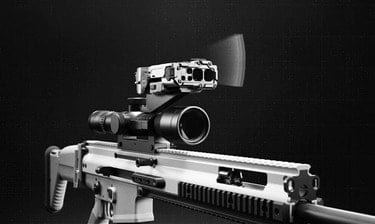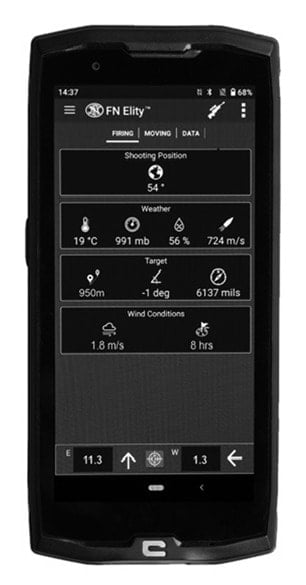In June 2025, at the Multinational Combat Training Center in Hohenfels (Germany), a soldier aimed his rifle directly at an unmanned aerial vehicle (UAV) flying overhead during a field training session. When advanced intelligent fire control systems are integrated into assault rifles, infantrymen will have more ability to deal with unmanned targets, thereby enhancing their maneuverability and reaction speed on the battlefield.
Continuously intelligentizing
The core secret of the assault rifle's ability to counter UAVs lies in the combination of an electro-optical aiming module and an AI-powered fire control mechanism. The system is equipped with high-performance sensors and image processing software, which can scan and identify targets in the air or on the ground, use computer vision algorithms to lock on to targets and calculate ballistic trajectories in real time, achieving "one-shot" capability.
Currently, AI and many new technologies are being widely applied in the military field, rapidly promoting the process of transforming warfare into a smart phase. Smart weapons are an important step in the process of preparing and responding to smart warfare, and at the same time are the foundation for forming smart combat capabilities. What changes have new technologies brought to traditional rifles? Why are countries racing to develop smart guns?
Guns are the most basic weapon of a soldier, and also one of the most important firearms in human history.
Early aiming devices were very simple: a fixed sight mounted on the barrel end, a U-shaped sight mounted on the rear of the gun. The entire aiming process was completely dependent on human eyesight. In special conditions such as night, dense forests, mountains or bad weather, obstructed vision would significantly limit the range and accuracy.
To overcome this limitation, optical sights were born. During World War I, the German army was the first to use rifles with optical sights and achieved certain successes. However, the sights of this period were of very diverse origin and quality, affecting the effectiveness of combat.
During World War II , German and Soviet snipers often engaged in fierce confrontations among the rubble. German sniper rifles often lacked windage adjustment, which significantly reduced their effective range. Soviet optical sights, while improved, were still highly dependent on the individual skill and tactics of the shooter.
After World War II, countries continued to improve the sight. The Soviet Union developed the PSO-1 sight for the SVD sniper rifle with a simple design, which can measure distance with an integrated scale plate. It also integrates a light plate, an infrared emitter and a photosensitive screen, which helps increase adaptability in harsh environments. Although the design is still crude, the operating principle of the PSO-1 has greatly influenced modern sight models. In addition to improving the optical components, people also equipped night vision goggles, tactical lights... to enhance the gun's full-time and all-terrain combat capabilities.
In the second half of the 20th century, semiconductor technology allowed the miniaturization of fire control systems, previously only used on self-propelled artillery. Since then, some sniper rifles and grenade launchers have integrated fire control systems.
Thanks to the development of microelectronics, new materials and gun manufacturing technology, tactical accessories have been integrated with electronic microchips, forming an intelligent fire control system. This system has a miniature computer, laser distance measuring sensor, wind sensor... combined with control algorithms, helping to identify targets, measure distances, track and predict bullet trajectories. Thanks to that, the combat capability of soldiers is improved, training costs are reduced. Although the trigger is still performed by humans, the decision to aim and shoot is increasingly taken over by computers.
 |
Infantry guns are equipped with the FN Elity intelligent fire control system. |
The race between military powers
Currently, intelligent fire control systems are one of the key research directions of many countries in developing a new generation of infantry guns.
The United States is a pioneer in this field. Since the 1990s, the United States has equipped the XM104 system for the XM29 personal weapon. The XM104 integrates a sight, compass, rangefinder and thermal imaging device, forming a simple fire control system with some intelligent features. However, it has disadvantages such as short battery life, high cost, and heavy weight.
In 2018, the US Army launched the “Next Generation Combat Weapons” program. In 2022, Vortex Optics won the contract for the fire control system with the XM157 product. The design of the XM157 is compact, equivalent to a conventional sniper scope. It integrates a digital compass, a laser rangefinder, a ballistic computer, and an optical/infrared image sensor, allowing for 1 to 8 times zoom. The XM157 displays ballistic data on an integrated screen and is expected to be equipped with 250,000 units in the next 10 years. However, the XM157 still has disadvantages: the brightness in the glasses is not clear enough, it is difficult to see in strong light conditions, the laser measurement center is clearly off-center, and there has been an error in freezing the infrared image. In particular, the price is very high, up to 10,000 USD.
Israel also developed the SMASH system, now in the SMASH 3000 generation, which is of interest to the US and British armies. This system is compatible with AR guns, has a battery life of up to 72 hours, can connect to command, information, computer, sensor systems and flexibly switch between normal and smart aiming modes. SMASH uses artificial intelligence to identify moving targets, lock on to targets and control the trigger. When the system confirms the possibility of hitting, it will automatically activate the trigger. This system has demonstrated the ability to shoot down small UAVs in real combat.
FN Herstal (Belgium) developed the Elity system, which was selected by the French army. Elity integrates laser target designation, distance measurement, meteorological sensors and is mounted via Picatinny rail. However, Elity does not directly integrate a sight, allowing the gunner to choose the appropriate sight for each mission.
In Russia, the progress of research on intelligent fire control systems is still slow. The MP-155 Ultima (2020) gun model simply integrates electronic equipment with the gun. The plan to develop the first smart rifle of Kalashnikov was announced in 2021, but there has been no further update.
The need for precision fire on the modern battlefield has spurred the development of intelligent fire control systems. Current systems are capable of target recognition, trajectory calculation and trigger control. However, they still face challenges in terms of weight, cost, battery life and durability.
 |
| Intelligent fire control system displays various types of data visually on the screen. |
Smart weapons – soldiers need to be smarter
Combining guns with intelligent fire control systems is an irreversible trend. Compared to traditional optical sights, this system has outstanding advantages, such as: Operation in all conditions. Integrating night vision, infrared and normal light sensors, supporting gunners to identify and aim day and night, in all terrains and weather.
Second, increase accuracy without manual calculation. Thanks to laser measurement technology, image sensor and computer algorithm, the system displays target parameters, increases the efficiency of shooting moving targets, and reduces errors caused by manual calculation.
Third, it reduces training time and costs. Contrary to the old view that it takes years and thousands of bullets to train a good shooter, the smart system allows novices to achieve the same accuracy as professional soldiers thanks to the automatic calculation system.
The development of technology is promoting the process of intelligentizing single-soldier combat. Currently, the Picatinny rail has been developed from a device attachment accessory into an intelligent platform that integrates power supply, information processing and display, allowing the transmission of images from the sight to the personal display device, supporting the shooter to aim without having to approach the gun.
The intelligent firepower system can also be connected to a modern command and control system. Frontline target data can be transmitted to the command post, creating a real-time battlefield situation map, helping commanders make accurate decisions. The system also provides feedback on ammunition and battery status, providing accurate and timely logistics support.
As individual firepower systems connect to intelligent control networks, a profound revolution is underway: Soldiers become “smart buttons” on the battlefield, connecting and coordinating with unmanned systems and next-generation combat platforms. The rapid development of artificial intelligence and electronic technology has opened a new chapter in the modernization of infantry weapons. In the context of increasingly high-tech warfare, intelligent firepower control systems not only enhance individual combat capabilities but also help connect soldiers to the entire digital battlefield system.
However, industry experts say: "No matter how smart the system is, the person who pulls the trigger in the end must still be a well-trained soldier." The more modern the weapon, the more stringent the requirements for humans. It is both an expansion of human capacity and a challenge to human intelligence.
THANH SON (according to xinhua.net)
* Readers are invited to visit the World Military section to see related news and articles.
Source: https://baolamdong.vn/tu-dau-ruoi-den-ai-su-phat-trien-cua-cong-nghe-ngam-ban-tren-sung-bo-binh-382722.html







![[Photo] Super harvest moon shines brightly on Mid-Autumn Festival night around the world](https://vphoto.vietnam.vn/thumb/1200x675/vietnam/resource/IMAGE/2025/10/07/1759816565798_1759814567021-jpg.webp)





























































































Comment (0)